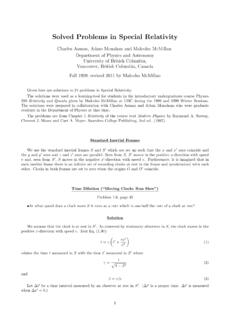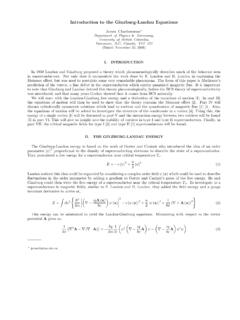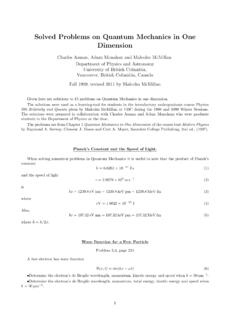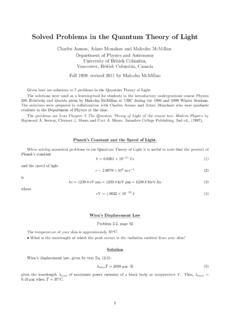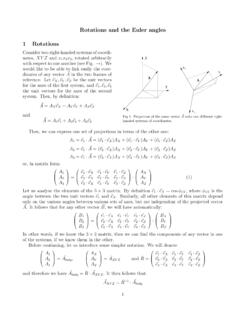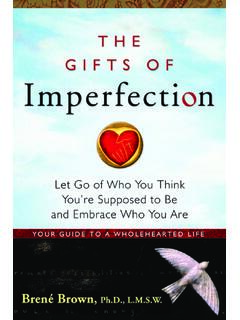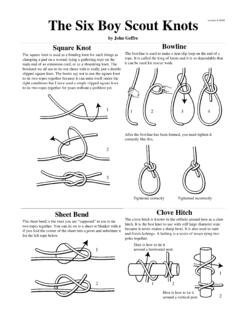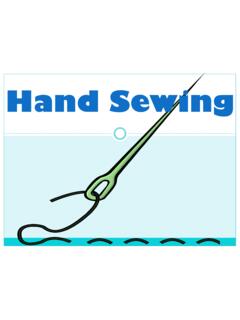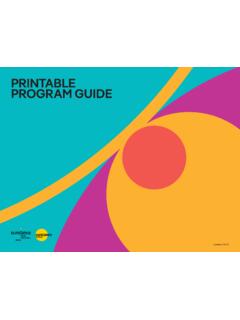Transcription of QUANTUM PHYSICS: Some Basics - University of British …
1 QUANTUM physics : some Basics 1: QUANTUM BEHAVIOUR QUANTUM mechanics confronts us with a remarkable situation. On the one hand, QUANTUM mechanics is by far the most successful scientific theory ever created. Indeed, it still has no known limits, and its application to physical systems ranging over 47 decades of length scale, from 10-21m (a million times smaller than a proton) up to 1026m (or 1011 light years, the size of the visible universe) has completely transformed our understanding of the physical world. On the other hand, this incredibly powerful theory is, in a quite profound way, incomprehensible to us, because of what it says about the nature of physical reality. In what follows a sketch is given of some of the key ideas in QUANTUM mechanics, and in section 2 we will see how these should lead in practice to some very startling new technologies in the next few decades.
2 1 (a) The Superposition Principle : We are so used to the idea that a physical system is in some definite state, that it is hard to imagine things otherwise. Statements like there is a ball on the chair , or the book is open , assume that physical objects are in a definite state (otherwise it is hard to imagine what is in these phrases means, or what the verb to be would signify). In a very deep way, we feel that physical reality involves definite objects which are in definite physical states. Thus, we can put a coin flat on the table, and not only is the coin itself assumed to be real , but it also definitely has either heads or tails facing up (ie., it is in a definite physical state of either heads or tails ).
3 However QUANTUM mechanics says something very different, and apparently nonsensical- that a physical system like a coin can simultaneously be in a state of both heads and tails ! This is called a superposition of states in QUANTUM mechanics. According to QUANTUM theory, if a physical system can exist in any one of a set of different physical states, then it can also exist in any superposition of these. For example, suppose we have a system that can exist in ordinary classical physics in one of 2 different states- a coin is a good candidate, existing in a state of heads or tails . In QUANTUM mechanics we can form a superposition of both heads and tails- as though the coin was simultaneously in both states!
4 Physicists write such superpositions in a simple way. Suppose we label a state heads by the symbol |+> (here the + means heads , and the | > indicates we are talking about a QUANTUM state). In the same way, the state tails is labeled by |--> . Then a superposition of equal parts heads and tails is written as (|+> + |-->). Note this superposition is a single definite QUANTUM state- the bizarre feature is that this state can be a superposition of several different classical states (where by classical states we mean the states we are used to in ordinary common sense life). |+> + |--> = + Fig. 1: A superposition of heads and tails The difficulties attending such superpositions were highlighted in 1935, when Schrodinger described how according to QUANTUM mechanics one might put a cat (now called Schrodinger s Cat ) simultaneously into a superposition of live and dead states.
5 Schrodinger s argument was intended to show that bizarre superpositions of radically different classical physical states were logically possible in QUANTUM mechanics. For many years most physicists took Schrodinger s Cat to be a reductio ad absurdum (as did Schrodinger), and assumed that macroscopic QUANTUM states must in some way be absolutely forbidden. However, starting in 1979 with theoretical work of Leggett and collaborators, it was shown that macroscopic QUANTUM superpositions could indeed exist under special circumstances (although a superposition of live and dead cats is probably a fantasy), and they were first prepared experimentally, in superconductors at low temperature, in 2003. They are expected to be crucial to any future QUANTUM technology.
6 1(b) QUANTUM Entanglement : The idea of superposition is bad enough for our common sense views, but it is certainly not the most bizarre feature of QUANTUM mechanics. This honour falls to what is called entanglement . Consider TWO coins- let s call them coin A and coin B- and suppose we correlate their behaviour so that, eg., they must always have opposite states (NB: to physically correlate them can be done in various ways- in fact any interaction between them will, in QUANTUM mechanics, lead to some kind of correlation). Now there are 2 possible ways for the coin states to be oppositely oriented. One is to have coin A as heads, and coin B as tails- this state would be written as |+ -->. However we could also have coin A as tails, and coin B as heads- this state would be written as | -- +>.
7 Common sense tells us that we must have one situation or the other. However in QUANTUM mechanics, again, we can have a superposition of the two possibilities- giving a state which is written as (|+ --> + |-- +>); see figure below: |+ --> + |-- +> = + Fig. 2: An entangled pair of coin states, as described in text. Now the startling thing is that in such a superposition, we can attribute no physical state to either of the coins separately - only the PAIR of coins is in a definite state. Thus when 2 physical systems are in an entangled state, the physical state of one of the systems on its own does not exist- only the pair state is physical real. We see that entanglement demands a radical revision of our notion of reality.
8 The conflict between QUANTUM notions of reality, and very deeply-entrenched common sense intuitions, is certainly the most difficult philosophical problem raised by modern physics . Many have simply refused to accept such strange ideas. The most notable objections came from Einstein: starting from the famous Einstein-Podolsky-Rosen paradox (1935), he argued that QUANTUM mechanics must be incomplete, by showing that entanglement led to apparently nonsensical experimental consequences. To the end of their lives, Einstein and Schrodinger never accepted that physical reality could be this way. However, experiments in the last 25 years have not only confirmed entanglement in the lab, but shown it can be used as a tool to do incredible things - discussed in section 2 below.
9 Nowadays one talks of entanglement as a new resource (meaning, amongst other things, that it can be used to develop new technologies- see below). Fig. 3: Two of Walt Disney s images of the power of modern QUANTUM physics , embodied (LEFT) in a malevolent genie towering over the fisherman, or (RIGHT) in a benevolent genie, whose power is harnessed for the good of all (from Our Friend the Atom (1964)). Walt Disney summed up, in his remarkable film Our Friend the Atom , the 2-sided face of QUANTUM mechanics that we now perceive, by the analogy of an Arabian genie. On the one hand, a theory of apparently limitless scope and power, quite unprecedented in previous human history, and on the other hand, an interpretation and an associated ontology that seem mysterious & paradoxical.
10 Nobody can truly claim to understand QUANTUM theory, and some of its greatest practitioners feel instinctively that it must somehow be flawed or incomplete, despite its unparalleled success. Others argue that it is here to stay, and the flaw is in our own intuitions of reality. Whatever one may think about these essentially philosophical issues, they can no longer be ignored- in the next few decades, macroscopic devices will be built which depend essentially on entanglement and superposition for their operation, bringing uniquely QUANTUM -mechanical phenomena into our everyday world. 1 (c) Key Features of QUANTUM Mechanics: As indicated above, QUANTUM mechanics has been applied to virtually every physical system we know, with extraordinarily revealing consequences.
